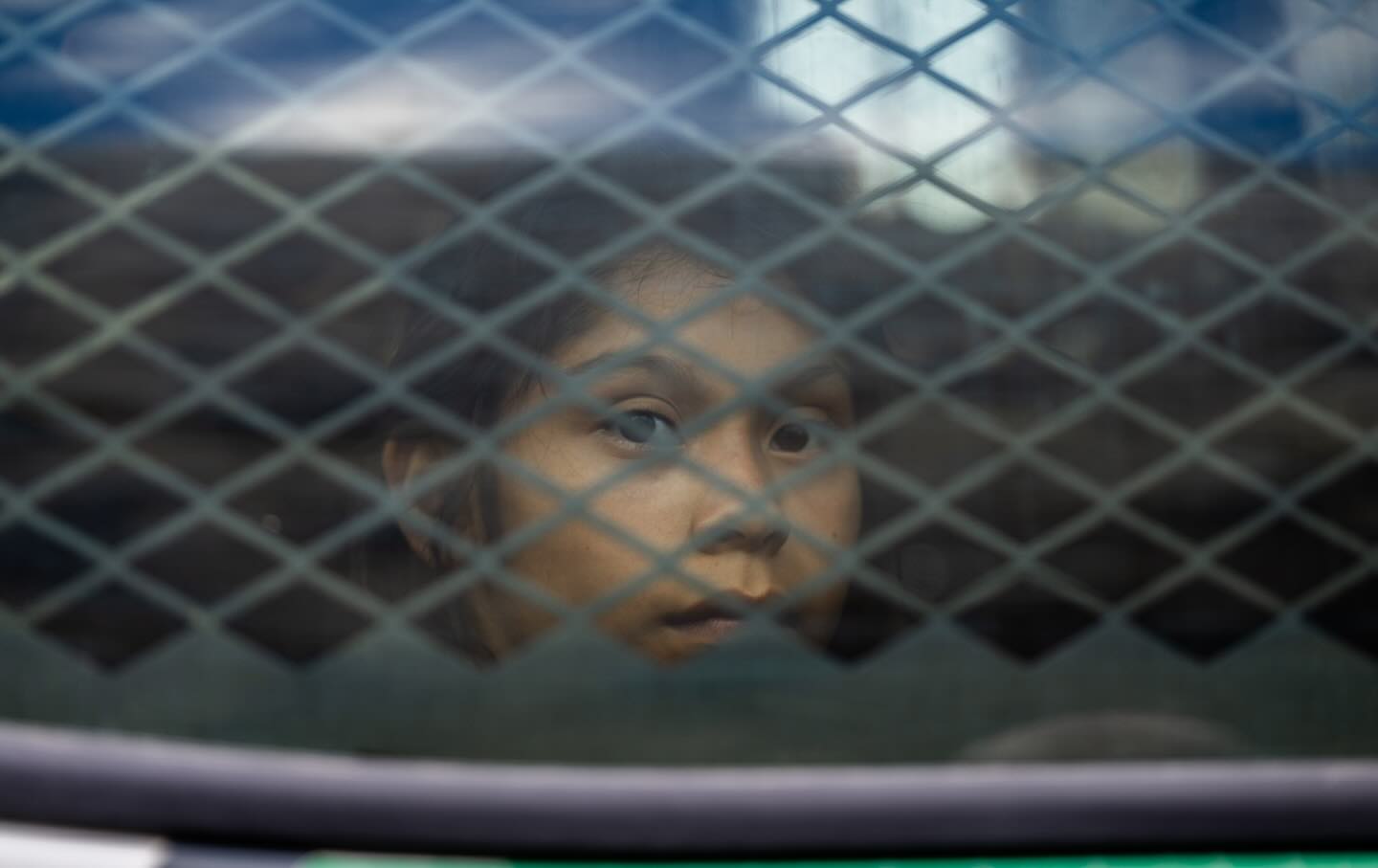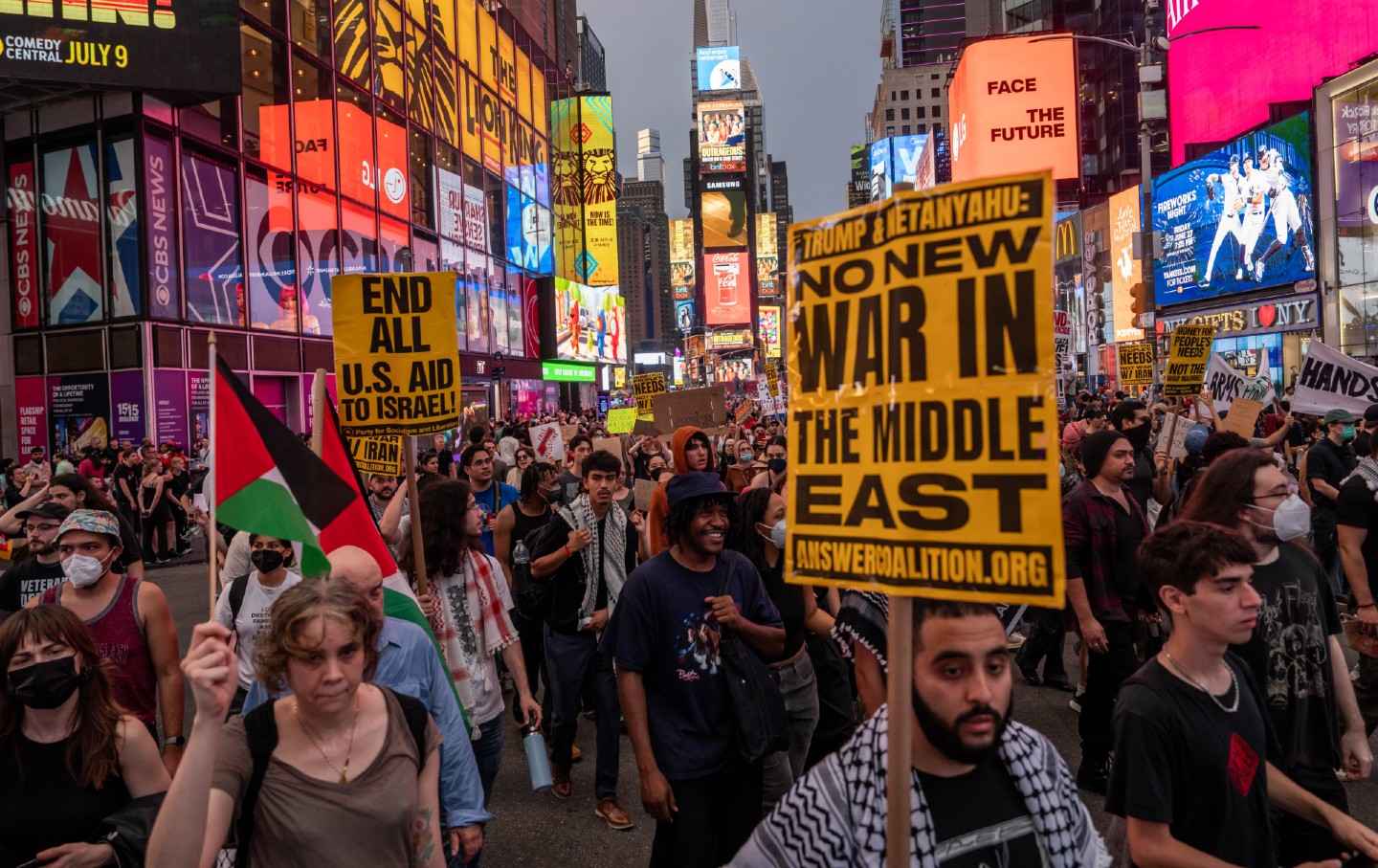The US and Israel have launched a war of aggression against Iran, based on lies. We are all now in deep, uncharted waters.

A young Iranian girl holds a country flag during a protest to condemn the US attacks on Iran’s nuclear facilities in downtown Tehran, Iran, on June 22, 2025.
(Morteza Nikoubazl / NurPhoto via Getty Images)
In the early hours of June 22, what the world had feared for decades—the thing that had been warned against as the one action that could set the Middle East fully alight—finally happened. American stealth bombers, armed with nearly 30,000-pound bunker busters, struck Iran’s nuclear facilities, casting us all into deep, uncharted waters.
In the end, the strike was due to circumstances many had long foreseen—with Israel launching a war with Iran and then pulling the United States into the ensuing storm. Donald Trump, for all his “America First” posturing, proved to be easily malleable for Benjamin Netanyahu, Fox News, and the neocons lurking around Washington, going from hesitating to get involved to demanding Iran’s “unconditional surrender” in just a few days. “God Bless Israel” even came before “God Bless America” in the president’s speech announcing these strikes.
The shock of our new normal still lingers, but this was always coming. Like a pot being brought to a slow boil, the past two years of regional conflict—from the US-backed genocide in Gaza to Israel’s attacks on practically all of its neighbors—have broken past nearly every previously existing law of war, every red line, every seeming shred of rational thinking shielding the Middle East from the precipice of total disaster. In keeping with such a wretched trend, a significant American attack on Iranian soil, carried out after the US openly deceived the country during alleged nuclear negotiations, should have been seen as an inevitability.
Even in the world of US intelligence, the consensus has long been, and continues to be, that Iran does not have a nuclear weapons program. It had signed up to a nuclear deal to enrich at civilian levels during the Obama administration that Trump then tore up in his first term. It had been in negotiations with the US and Israel—the latter of which actually has hidden a nuclear weapons program from the world (and IAEA inspectors) for decades—when those two states launched this war. But in the aftermath of the US strikes, America’s unparalleled ability to turn reality on its head was on full display.
When his own director of national intelligence, Tulsi Gabbard, echoed the conclusions of the intelligence community, Trump said plainly that he “didn’t care.” Later on, Trump said, even after he unilaterally attacked another country without congressional authorization, that “NOW IS THE TIME FOR PEACE!” In his address to the nation, Trump again called on Iran to “make peace” in a war that Israel had started and America had now accelerated.
Iran had been told to surrender its sovereign, internationally recognized right to enrich uranium in exchange for zero sanctions relief through “negotiations.” It refused. Now, after being shaken by bombs and murder, Iran was being told, explicitly, to surrender again. It is again refusing.
Foreign Minister Abbas Araghchi has stated that Iran reserves the right to a “legitimate response in self-defense.” President Masoud Pezeshkian joined crowds of demonstrators in Tehran demanding a response to the American attacks. Supreme Leader Ali Khamenei, hidden away in a secret location to avoid an assassination strike, has yet to comment but is unlikely to suddenly decide to acquiesce.
Still, even as the Iranian establishment remains united as ever on the question of Iran’s right to respond to such aggression, what it can do in this moment is much less defined.
Iran now stands at an undeniably difficult crossroads. It’s being offered a cursed off-ramp: an opportunity to save face, as it did following the October 2024 attacks by Israel. Then, the Iranian state was quick to brush off the attacks, dismissing them as insubstantial. Four Iranian soldiers were killed, but the pledge of a sure retaliation felt like reflex rather than a promise.
Here, the stakes are far larger on either side of the equation. Hundreds of Iranians have so far been killed, and Israel and Iran are continuously exchanging missiles. Iran’s nuclear facilities at Fordow and Natanz lie severely damaged, though admittedly not completely “obliterated” in the way Trump first claimed. The United States has already declared a massive victory, and Israel says that it hopes the war will end this week. The Iranian media initially attempted to claim damage was more limited at Fordow and that people in nearby Qom were unaffected, even as anchors on state TV promised severe retaliation that would make “the fires in Los Angeles” look like nothing, and as Qom’s representative in parliament asked Trump to begin making coffins for the American soldiers who would be sure to soon die.
Despite all these threats, Iran must operate within the reality that so much US propaganda seeks to obscure: that it is a non-nuclear country fighting two nuclear-armed states, including the most powerful military in the history of the world. An extended shooting war with the United States, no matter how much its military has trained for this, is a severe risk, to say the least. In attempting to avoid this, Iran arguably has no good options.
If it acts on its previous promises to meet American strikes with strikes on American bases around the region, further and more devastating American involvement is almost guaranteed. If it moves to instead close the critical waterway of the Strait of Hormuz, as former cabinet ministers and national newspapers are now advocating, previous American military promises to keep the strait open by force would undeniably be brought back to the fore. If it chooses more dramatic diplomatic moves, like withdrawing from the Non-Proliferation Treaty that forbids nuclear weapons (as many parliamentarians are now advocating), there is no indication that the Iranian government would even pursue the logical outcome of that decision. IRGC Maj. Gen. Mohsen Rezaee and President Pezeshkian have signaled that they still will never seek nuclear weapons because of Khamenei’s fatwa against those weapons.
If Iran does decide to retaliate and America becomes even more involved, in whatever form that may take, the foreign allies that Iran could call to its aid are not what they used to be, pre–October 7. The late Hezbollah leader Hassan Nasrallah once promised that “war against Iran would mean war against the entire Resistance Axis.” Nasrallah has now been assassinated by Israel, and Hezbollah, once Iran’s strongest non-state ally, is no longer in a position to intervene, advocating instead that people raise their voices against the war.
Houthi military officials announced before the strikes that they would restart their Red Sea blockade against American commercial vessels and strike American warships if America entered the war against Iran. Though one of their spokespeople at first said following the strikes that the threshold had been crossed, the threat appeared to have been walked back several hours later when it became clear that Iran had not asked them to do that on its behalf just yet.
There have been sparks of the kind of collective retaliation promised in battles past: Iraqi groups have promised reprisals against American bases inside their own country, and even South Asian groups like Liwa Fatemiyoun have vowed to attack Western interests in Pakistan should Khamenei be assassinated, as has been previously threatened by Israeli officials and by Trump himself. As for what these groups can actually do now, one cannot escape the recognition that it pales in comparison to what could be done before the so-called Axis of Resistance began to crumble last year.
Popular
“swipe left below to view more authors”Swipe →
This leads to the question of what may occur if Iran, by however unlikely a chance, chooses “peace”—that is to say “peace” in the Trumpian parlance. Iran would likely be put on the path to eliminating all of its nuclear capabilities under American supervision, with no promise of sanctions relief, and with not even the guarantee of a true-blue ceasefire. As in the supposed ceasefires with Gaza and Lebanon, Israel has had the ability to continue to strike unilaterally, sometimes daily, at anything it perceives to be a threat, while the other party has no recourse whatsoever. Meanwhile, Israel prepares to initiate another war against a now much more weakened and isolated enemy.
Iran may be buying time to figure out its next move, but the clock is ticking. The drums of further war are already beginning to beat as American media outlets conjure up fantasies of Iranian “sleeper cells” running around the United States, and Vice President JD Vance saying that Iran’s uranium stockpile, unaffected by these strikes, will need to be dealt with “in the coming weeks.” Vance insists that these will be dealt with through “conversations with the Iranians.” Iran’s recent history with such conversations does not inspire much trust.
Eventually, Iran’s ballistic missile supplies will run low, with its production interrupted and its military still under constant fire. In imposed conflicts, rarely does the country war has been imposed on have many good options. In Iran’s case, not only can it not trust the Americans but it cannot trust Europe, whose nations are also now demanding zero enrichment, either. The country is now being forced in record time to reconsider its regional alliances, its military strategy, and its outlook for the future. Regardless of what happens in the next few weeks, nothing will be the same. Despite the difficult choices for Iran, and the Middle East, that are ahead, some Houthi officials remain optimistic. Abdul-Malik al-Ejri, a political bureau official, wrote on X the night after the American attacks:
There are deep-rooted changes in the structure of the international and regional order that no political force, no matter how powerful or tyrannical, can stop. Yes, they can destroy and devastate, they may be hindered or delayed for years, but they will not stop. Great empires have tried to halt historical transformations at the height of their supremacy, but history’s cunning was always stronger.”
Every day, The Nation exposes the administration’s unchecked and reckless abuses of power through clear-eyed, uncompromising independent journalism—the kind of journalism that holds the powerful to account and helps build alternatives to the world we live in now.
We have just the right people to confront this moment. Speaking on Democracy Now!, Nation DC Bureau chief Chris Lehmann translated the complex terms of the budget bill into the plain truth, describing it as “the single largest upward redistribution of wealth effectuated by any piece of legislation in our history.” In the pages of the June print issue and on The Nation Podcast, Jacob Silverman dove deep into how crypto has captured American campaign finance, revealing that it was the top donor in the 2024 elections as an industry and won nearly every race it supported.
This is all in addition to The Nation’s exceptional coverage of matters of war and peace, the courts, reproductive justice, climate, immigration, healthcare, and much more.
Our 160-year history of sounding the alarm on presidential overreach and the persecution of dissent has prepared us for this moment. 2025 marks a new chapter in this history, and we need you to be part of it.
We’re aiming to raise $20,000 during our June Fundraising Campaign to fund our change-making reporting and analysis. Stand for bold, independent journalism and donate to support The Nation today.
Onward,
Katrina vanden Heuvel
Publisher, The Nation
More from The Nation

Israel’s assault on the Iranian capital has brought destruction and grief to civilian neighborhoods.

Forcing people to move or prohibiting their mobility are two sides of the same colonial or neocolonial coin.




